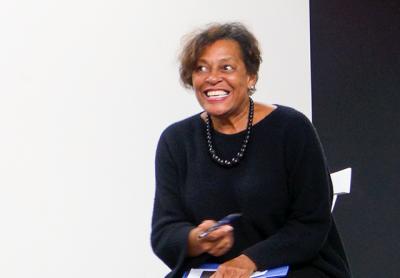‘Grace Notes’ and More: Works in Process

The Watermill Center’s “In Process” series has a specific mission. As she introduced Saturday’s program of works-in-progress by three current resident artists — Carrie Mae Weems, Lexy Ho-Tai, and Lotte Nielsen — Elka Rivkin, the center’s director, said, “We try to do something in the middle of each residency that gives an audience an opportunity for a window into what the creative process is, or could be, for different artists.”
“Grace Notes: Reflections on Now,” a multimedia piece that Ms. Weems is working on, is much more fully developed than some other projects, having been previously presented at the Spoleto Festival and the Yale University Theater. In her 30-year body of work, Ms. Weems has used photographs, text, fabric, audio, installation, and video to explore family relationships, gender roles, and the history of racism, sexism, and various political systems.
She discussed the genesis of “Grace Notes” prior to the performance. “I conceived this project several years ago,” she began. “I wrote to 30 or 40 artists with the idea that we would put together a thank-you to Barack Obama for his service to this nation. By that afternoon, 20 or 30 had already replied to the idea.”
She approached poets, composers, writers, and choreographers to help her develop the piece, with the idea of putting “all of it in a beautiful series of boxes that we would ship off to the president and eventually to the Presidential Library.” But as her collaborative team emerged, she realized that the work should be a performance.
While at the center, Ms. Weems has been trying to understand “the meaning of grace — not necessarily as a religious idea, but as a quality of being. Something that came to me in the process of working it out is that, in looking at what has happened to people in very difficult circumstances, it became clear that those people seemed to hold on to the core of their humanity.”
The performance consisted of Ms. Weems reading from her text, Carl Hancock Rux reading his poetry, video projected in the background, and an intermittent music soundtrack. Tanya Selvaratnam, who sat next to Mr. Rux across the room from Ms. Weems, also read from the artist’s writings.
The piece was somber, dark, and mesmerizing, as testified to by the hushed audience of about 90 people. Politics and race were key elements of the texts and the film footage, some of which was taken from early civil rights conflicts in the South.
Mr. Rux spoke of “everybody taking matters in their own hands, roaming the streets, knowing that by the year 2020 manifest destiny would be a thing of the past, boxed up and put away, and compelled by growing senseless thoughts as confederates and conservatives were coming out again, despising Obama and voting for Trump.”
“Tripped up by forces beyond their control, white men were disaffected and disenfranchised, and black men were disaffected and dying,” Ms. Weems read. “But both were devoid of power, blinded by rage and historical circumstance. Each blamed the other.”
She also detailed, elliptically, the history of violence against African-Americans, reeling off ages that referred to men and women who were killed: “He was 43, a father, a brother, an uncle, a cousin, a boy, a friend; she was 35. . . .” The names followed later — Trayvon Martin, Michael Brown, Eric Garner, and Freddie Gray among them. Brief video clips of the crime scenes ran in the background.
While both Ms. Weems and Mr. Rux noted that the piece has some lighter moments, she did say, during the question-and-answer period, that “working with this material on a daily basis can be brutalizing for the psyche, painful for the mind, the heart.”
While “Grace Notes” drew a sustained round of applause from an audience that was deeply moved, it was also with some relief that the final studio visit couldn’t help but lift visitors’ spirits.
Ms. Ho-Tai, who recently earned a B.F.A. in fashion design from the Parsons School of Design, characterized herself as “an explorer, dreamer, and maker of things. I like making all sorts of things. Mostly, I enjoy making things that ignite joy and make people smile.”
For the past year and a half, she has been working on “Kookerville,” an imaginary world “where your inner childhood takes form as Kookers,” or monsters, as she called them. Hardly frightening, these colorful, life-size figures are made from recycled and found materials, including newspapers and pieces of fabric wrapped together by wire.
Ms. Ho-Tai’s art is inventive and playful. “Kookerville” was her response to New York City, where she moved in 2012 from a small town in Canada. “Nobody seems happy there at all. So I wanted to create this world that would kind of be a fleeting moment of joy and spontaneity.”
A work in progress by Ms. Nielsen, a Danish artist whose ongoing video project “YAOI” includes footage of a long-abandoned cinema in Copenhagen and L.G.B.T. youth who hang out there, was introduced by Ms. Rivkin, Ms. Nielsen having had to return to Denmark unexpectedly to attend to a family matter.
In the short video sketch of a group of L.G.B.T. youth on the East End, the camera, shooting in extreme closeup and with jumpy informality, moves among a group of five or six girls, their faces often blurred by the movement of people getting between them and the videographer. The audio was mostly inaudible, so only fragments of dialogue could be understood, resulting in a tantalizing but elusive fragment.
Whether or not owing to Ms. Weems, who is African-American, Saturday’s audience was not only large but also diverse — unusually so for cultural programs on the East End. One visitor remarked, a bit wistfully, “We should build on this.”
